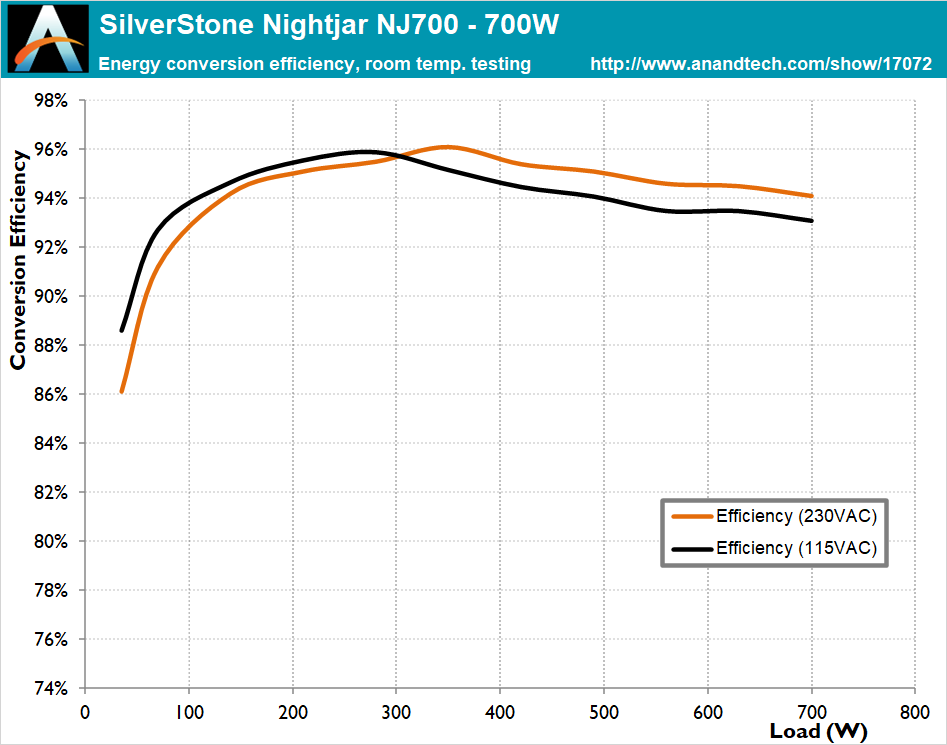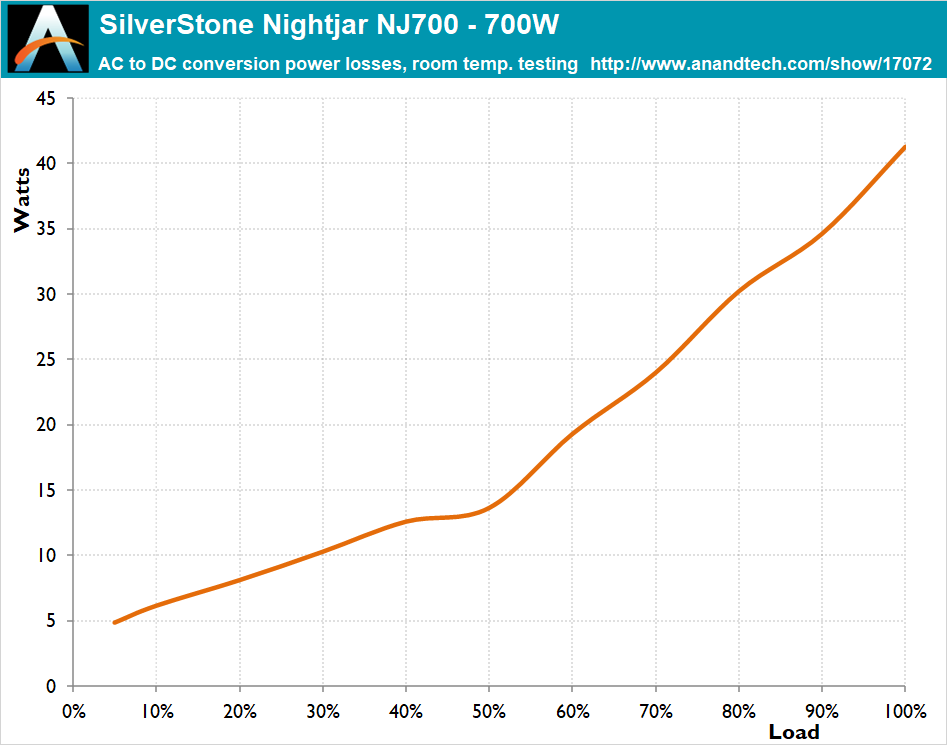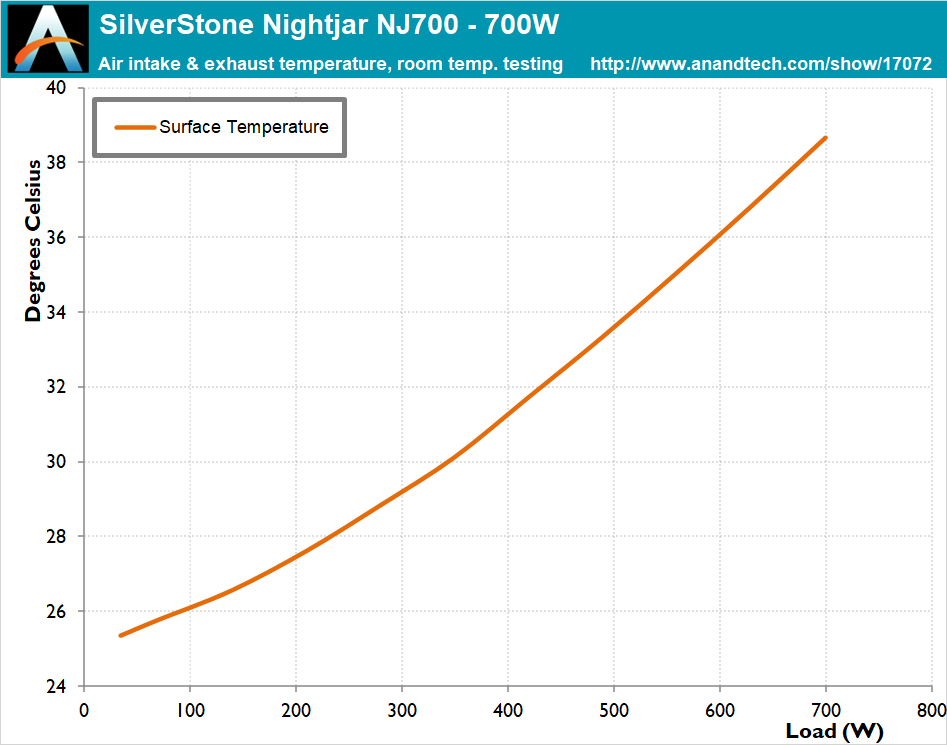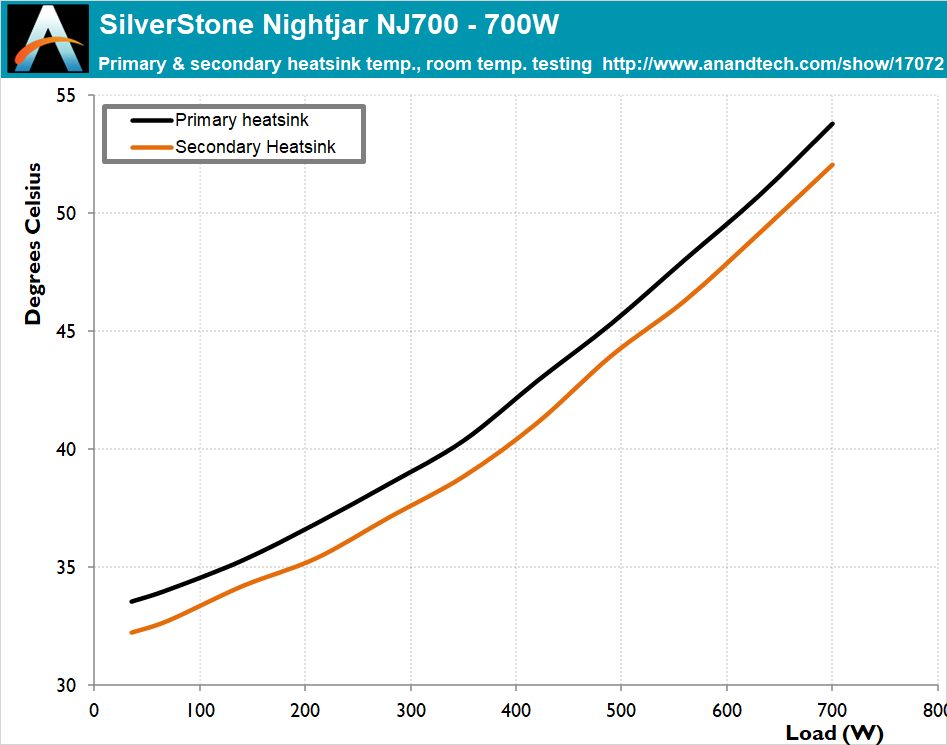The SilverStone NightJar NJ700 Passive PSU Review: Silent Excellence
by E. Fylladitakis on November 29, 2021 8:00 AM EST- Posted in
- Cases/Cooling/PSUs
- PSUs
- SilverStone
- Passive Cooling
Cold Test Results (~22°C Ambient)
For the testing of PSUs, we are using high precision electronic loads with a maximum power draw of 2700 Watts, a Rigol DS5042M 40 MHz oscilloscope, an Extech 380803 power analyzer, two high precision UNI-T UT-325 digital thermometers, an Extech HD600 SPL meter, a self-designed hotbox and various other bits and parts. For a thorough explanation of our testing methodology and more details on our equipment, please refer to our How We Test PSUs - 2014 Pipeline post.
Due to the unique thermal design of the Nightjar NJ700, we had to change our testing methodology quite a bit. As there is no airflow to assess, we placed a sensor on the bottom side of the chassis and measure its surface temperature instead. Note that these thermal results are not directly comparable with those obtained by testing regular air-cooled products.
As expected from a fanless PSU with this kind of power output, its efficiency is extremely high. Our measurements indicate that the SilverStone NJ700 surpasses the 80Plus Titanium requirements regardless of its input voltage. It has an amazing 95% average efficiency across the entire nominal load range when powered by an 230V AC source, which drops down by just 0.6% when the input is lowered to 115V AC. The efficiency at just 5% load is above 86% and the peak efficiency is above 96%.
As expected from any well-designed PSU without active cooling, the surface temperature increases almost linearly and in near-perfect alignment with the unit’s thermal losses. The surface temperature does reach over 38 °C, which is to be expected, as the body of the PSU itself partially acts as a heatsink. The heatsinks of the PSU do reach temperatures over 50°C when the power supply is heavily loaded but that is a perfectly safe figure for an advanced PSU. The primary side is getting a little bit hotter than the secondary side.














46 Comments
View All Comments
Rοb - Tuesday, November 30, 2021 - link
The only reason I see is that it's silver colored and says SilverStone on it, which might fit better with a SilverStone case build.SeaSonic's closest choices are black and white: https://seasonic.com/prime-fanless-tx or https://seasonic.com/prime-snow-silent
The choice seems fairly black and white to me too, unless you want SeaSonic's black and red 850W model; with advanced fan control - no harm in having a slow fan in the power supply to create a draft in a clearly useful direction, rather than relying on faster case fan speeds to guarantee that the flow through the power supply is above the minimum requirements.
tonyou - Monday, January 3, 2022 - link
Looks like the tuning we did to improve standby efficiency and reduced electrical noise/whine helped to make it perform a little better overall according to latest test result by TechPowerUp:https://www.techpowerup.com/review/seasonic-prime-...
Somewhat surprised Seasonic didn't bother to implement the changes made to our Nightjar NJ700 into their own retail version.
Arbie - Monday, November 29, 2021 - link
Quieter is better, and a passive design admirable - but the PSU adds little to the overall noise of my system. The fact that it can even be managed passively should tell you something. Case fans and CPU / GPU cooling contribute much more and I think always will.Oxford Guy - Monday, November 29, 2021 - link
‘the PSU adds little to the overall noise of my system’That’s one data point and we don’t know about all the variables. Your system could use Delta industrial fans at full tilt to cool its components or a recent Atom motherboard.
CharonPDX - Monday, November 29, 2021 - link
Impressive. I have a media center computer that has plenty of airflow around it that I'm trying to quiet down. It uses ~250-300W at "full power", I've always been using a 350-450W PSU in it, but this thing being most efficient at right around that power range seems very tempting.Oxford Guy - Monday, November 29, 2021 - link
‘This typically is not a concern for gamers, as the noise generated by the PC is often overshadowed by the speakers or headphones.’Strongly disagree.
I’ve read this headphones claim many times but even the kind of noise-blockers sold in hardware stores let some noise through.
A game that is designed to use subtle environmental sounds to create ambiance is generally going to be undermined by fan noise, especially if it uses PWM.
Trying to bury noise with speakers makes even less sense.
One of the things I especially disliked about the CD-ROM era of consoles was all the noise the machine outputted. As someone who started with fanless cartridge-based gaming the idea of it not being important to have a quiet unit — even with bleep/bloop arcade stuff, is one experience doesn’t support.
Young people are getting hearing damage from using headphones in noisy environments. Blasting music can mask noise but there’s a price to pay.
Wrs - Tuesday, November 30, 2021 - link
Active noise cancelation fixes this, though there are times when being environmentally unaware is a liability.Practically, I just find it quite hard to build a 700w system under 25db. Even water pumps and most radiator fans break that if loaded. Most those top PSUs with fans sit around low 20s dB at full load, and the noise is low frequency so very easy for ANC to deal with.
Oxford Guy - Thursday, December 2, 2021 - link
Citation please for the noise cancellation claim. If that’s true then the LRAD can be easily defeated by people wearing noise-cancelling headphones.I also think the claim that the total system noise is determined solely by whatever component produces the most noise is false. One 25 decibel fan is quiet. Five of them is louder. So, PSU noise can add to the sum.
Wrs - Saturday, December 4, 2021 - link
Which claim? The low frequency knack is common knowledge and I figure anyone who's tried ANC would discover it. Wiki ANC and search for "active vs. passive."I use ANC and barely hear the drone of 1500 rpm fans when my fully air cooled open case rig is loaded to >700 watts at the wall. Forget about hearing anything <1000 rpm with the -30 dB attenuation typical of low frequency ANC.
We're talking quiet office level sound of course. Idk if ANC can even be designed against an LRAD, where it's not even so much hearing damage as tissue injury from shock and cavitation.
Oxford Guy - Friday, December 10, 2021 - link
If noise cancellation is as good as you claim then it’s going to save a lot of people’s hearing. A recent journal article I read about subway commuters developing hearing loss from too much ambient noise didn’t mention such headphones. Curious that the pro researchers would miss something if it’s that effective. The only time I’ve seem headphone use discussed in an ambient noise hearing loss context is in terms of headphones making the problem worse via people simply turning up the volume.The pair of ‘noise-blocking’ headphones I tried had terrible hiss. PC Mag claims that that’s only seen in low-quality models but those were expensive Beats.
As someone who gets serious tinnitus flareups from computer fans (and possibly coil whine) I am certainly hopeful that this tech is the panacea you say it is.